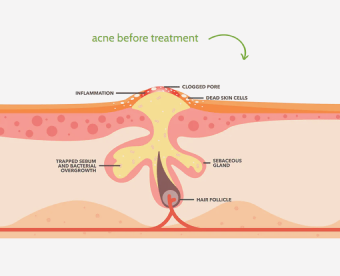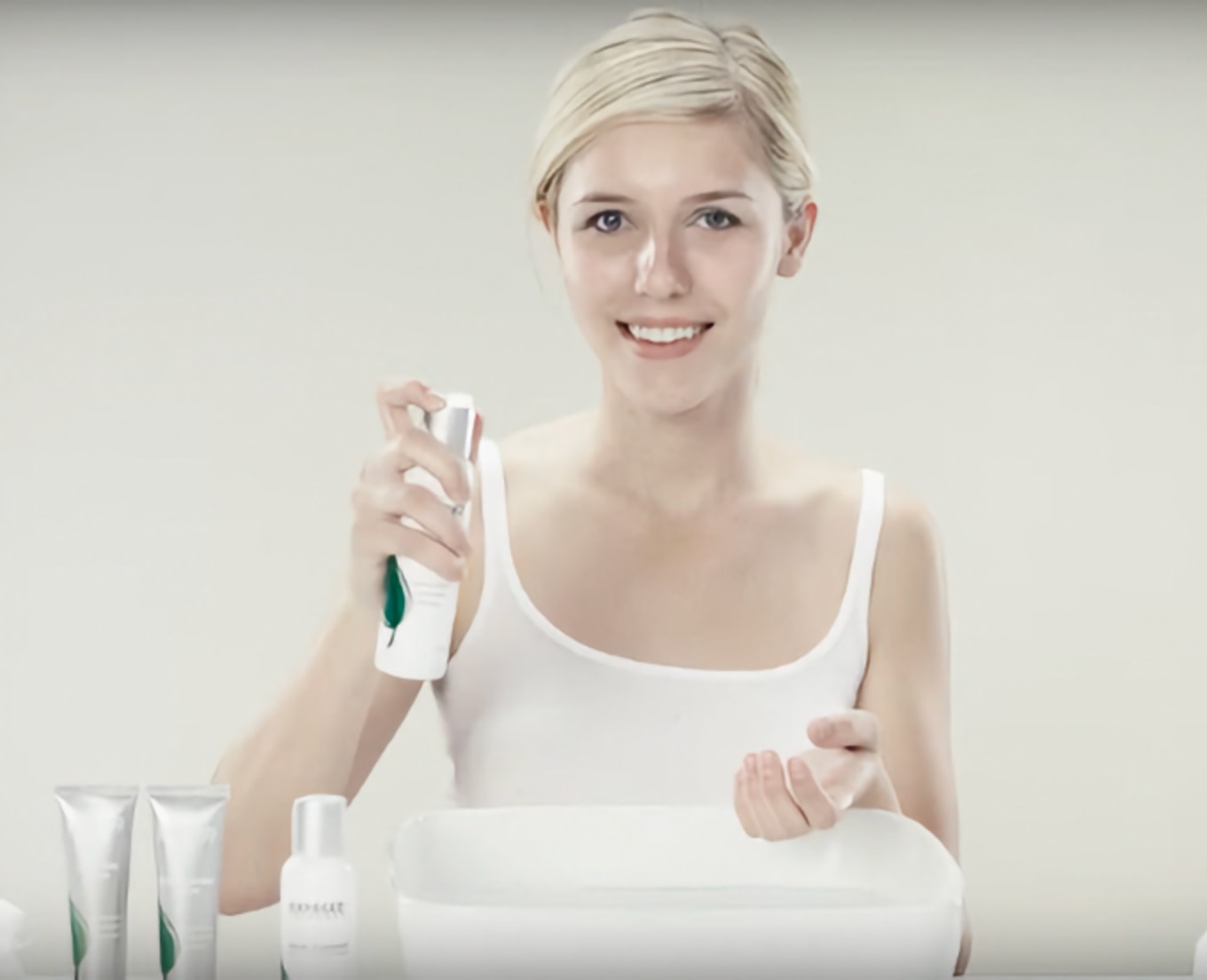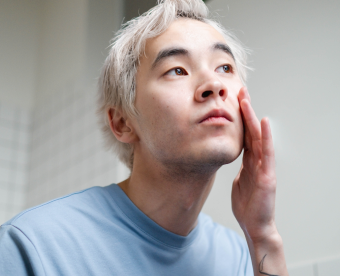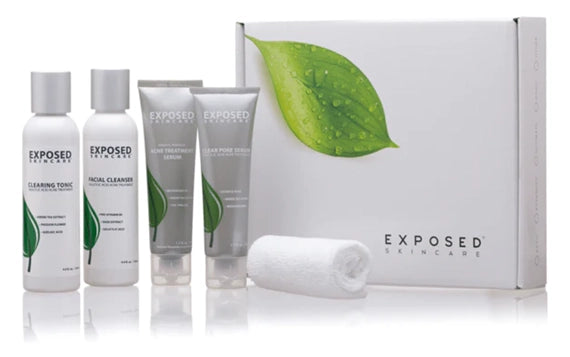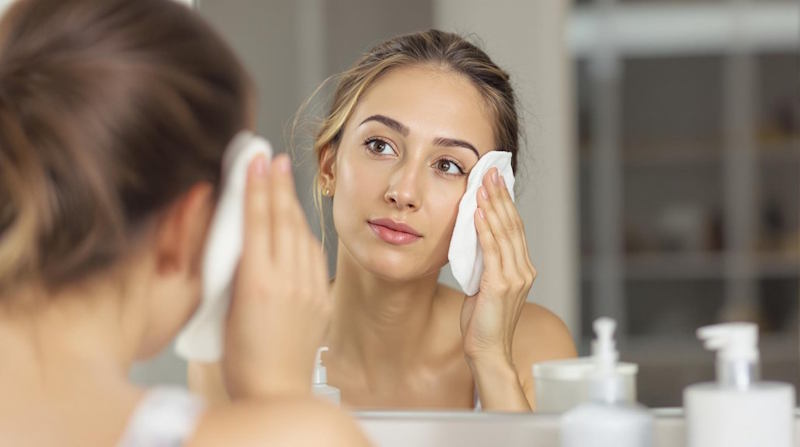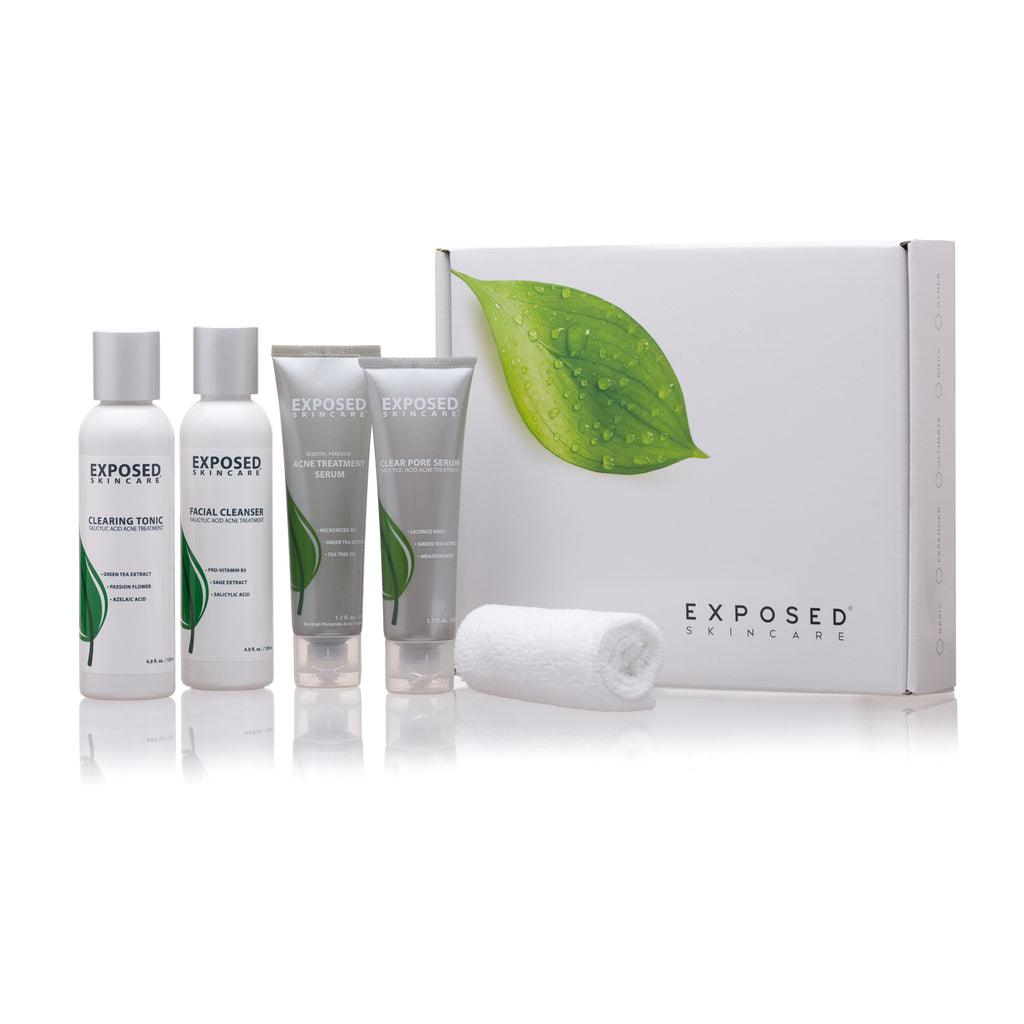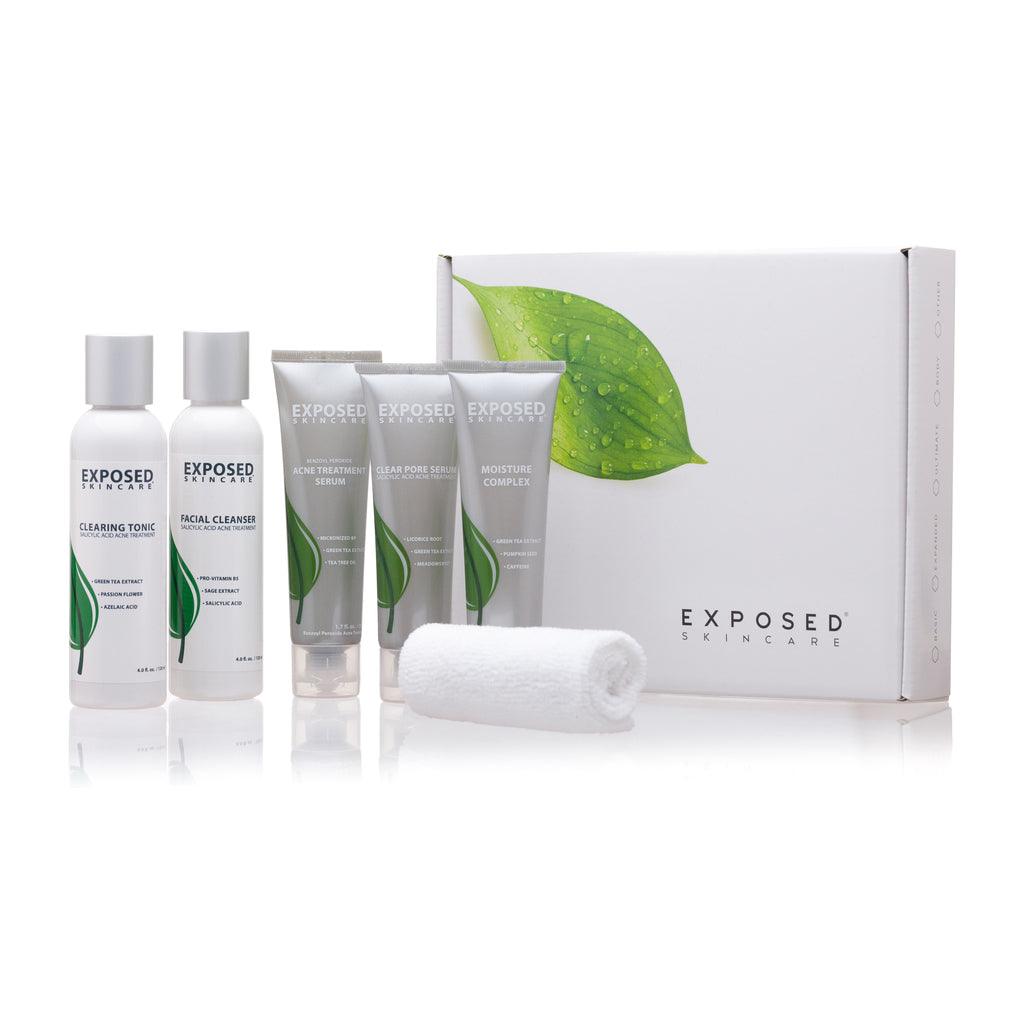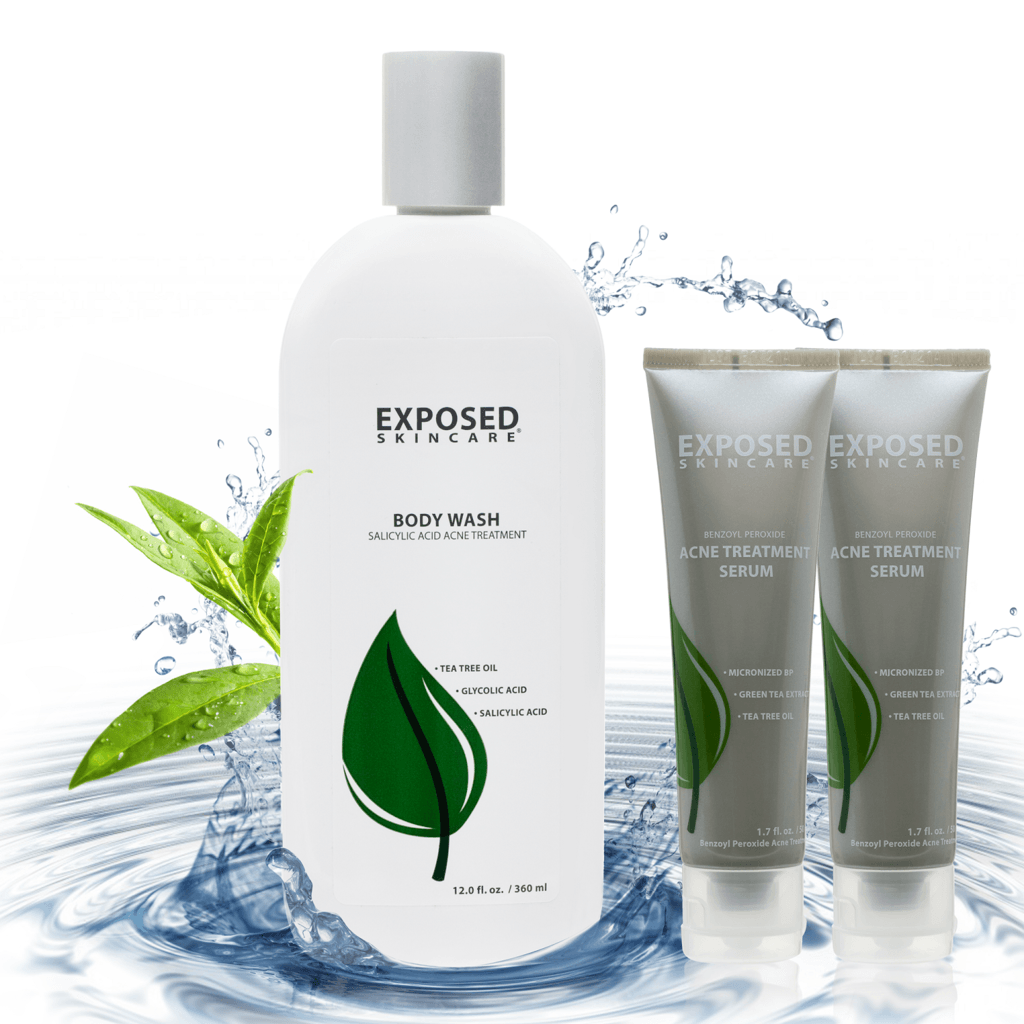Cystic acne shows up as deep, painful bumps that leave scars, while hormonal acne hits your jawline in sync with your period. They might look like cousins, but they need different battle plans. Exposed Skincare tackles both with its 4-driver approach—combining benzoyl peroxide for bacteria, green tea for oil control, acids for exfoliation, and botanicals to calm inflammation. Stick with a consistent routine and you'll uncover why one-ingredient solutions keep letting you down.
Biggest Takeaways
- Cystic acne presents as deep, painful bumps while hormonal acne typically appears along jawline and chin.
- Hormonal acne follows menstrual cycles while cystic acne is more persistent and prone to scarring.
- Exposed's 4-Driver approach addresses both acne types through micronized benzoyl peroxide, green tea, acids, and botanical extracts.
- Cystic acne often requires prescription treatments, while hormonal acne may respond to birth control or spironolactone.
- Consistent skincare routine with gentle cleansers, non-comedogenic moisturizers, and specialized serums helps manage both acne types.
Understanding the Key Differences Between Cystic and Hormonal Acne

When you're staring into the mirror at what feels like Mount Vesuvius on your face, figuring out whether you're dealing with cystic or hormonal acne matters more than most skincare blogs let on.
Here's the real deal on cystic acne vs hormonal acne: Cystic acne shows up as those deep, angry, pus-filled monsters that can appear anywhere on your face at any time.
They're painful, stubborn, and love leaving scars as souvenirs.
Meanwhile, hormonal acne plays favorites with your jawline and chin, showing up like clockwork with your period.
Think deeper nodules rather than surface-level drama.
The treatment game changes too—cystic acne often requires the big guns (prescription meds), while hormonal breakouts might respond to birth control or spironolactone.
Both types can wreck your confidence, but knowing which beast you're battling is step one.
The Science Behind Cystic Acne: Causes and Triggers
Let's plunge into the ugly truth about what's actually brewing beneath those painful cystic bumps you're battling. Cystic acne isn't just your average zit drama—it's a perfect storm where excess oil, bacteria, dead skin cells, and inflammation throw a raging party deep under your skin.
-
Your genes are major players—thanks, Mom and Dad, for that acne-prone DNA lottery ticket.
-
Hormonal chaos (puberty, periods, pregnancy) cranks up oil production like nobody's business.
-
Stress and crappy sleep habits? They're basically sending engraved invitations to breakouts.
-
That late-night ice cream and pizza binge isn't helping either—sugar and dairy can fuel the fire.
While everyone's pointing fingers at single culprits, the reality is cystic acne comes from multiple factors hitting you all at once.
Hormonal Acne: Why Your Chin Breaks Out Every Month

If you've noticed those deep, painful pimples that set up camp along your jawline and chin like clockwork every month, you're dealing with the classic calling card of hormonal acne.
What's happening? Your hormones are basically throwing a monthly rager in your oil glands. Up to 65% of adult women experience these cyclical breakouts, typically peaking right before your period hits.
Unlike regular acne, these stubborn cysts don't come to a head—they just lurk painfully beneath your skin.
The culprits? Androgens (yes, women have them too) that kick your sebum production into overdrive, creating the perfect breeding ground for bacteria.
Most "miracle" face washes fail because they're not addressing the hormonal component at all—kind of like using a band-aid for a broken arm.
How Exposed's 4-Driver Approach Tackles Deep Cystic Infections
Unlike those one-trick pony acne treatments flooding your social media feed, Exposed's 4-Driver Approach actually makes sense if you're battling those deep, painful cystic eruptions.
Instead of slapping on random ingredients that TikTok swears will work miracles, Exposed tackles all four culprits behind your angry underground zits.
-
Kills bacteria with micronized benzoyl peroxide that penetrates deeper than typical formulas
-
Controls excess oil using green tea extract without turning your face into the Sahara
-
Unclogs pores with salicylic and glycolic acids that exfoliate without irritation
-
Calms inflammation through botanical extracts that soothe angry, painful bumps
You're not just masking symptoms—you're hitting cystic acne from every angle.
And unlike those sketchy 30-day guarantees, Exposed backs their system with a full year to get clear.
Balancing Hormonal Fluctuations With Exposed's Botanical Ingredients

While most skincare brands slap "hormonal acne solution" on their labels and call it a day, Exposed actually packs botanical ingredients that address those crazy hormone swings driving your breakouts.
Tea tree oil and green tea extract don't just sound fancy—they're working overtime to calm the inflammation that hormonal surges trigger.
Meanwhile, willow bark (nature's salicylic acid) dives deep into pores to clear out the extra oil your hormones ordered up without asking you first.
What's genius is how these plant-powered ingredients team up with the clinical stuff. Instead of throwing random ingredients at your face, Exposed created a system that tackles hormonal chaos from multiple angles.
Your skin doesn't just need one hero ingredient—it needs a whole squad working together to keep those monthly breakouts in check.
Why Single-Ingredient Solutions Fail Against Both Acne Types
The harsh truth about those trendy single-ingredient acne products? They're setting you up for disappointment when dealing with cystic or hormonal acne.
These complex skin conditions don't bow down to one-trick-pony solutions, no matter how cute the packaging.
-
Your salicylic acid spot treatment can't touch the hormonal chaos causing those chin breakouts.
-
That fancy benzoyl peroxide cream? It's not reaching the deep inflammation fueling cystic monsters.
-
Tea tree oil might smell nice, but it's laughably outmatched against your monthly hormone surge.
-
Vitamin C serums are great for many things—solving multi-factorial acne isn't one of them.
When your skin's waging a full-scale rebellion, you need an arsenal, not a single weapon.
That's why Exposed's system tackles all four acne drivers simultaneously instead of leaving three problems untouched.
Real Results: Before and After Stories From Cystic and Hormonal Acne Sufferers
Four real humans with actual results tell a more convincing story than any marketing claim ever could.
Take Mia, who battled deep, painful cystic acne for years before a personalized regimen with Exposed's complete system knocked her breakouts down by 85% in just three months.
Then there's Alex, whose hormonal jawline eruptions predictably crashed every party right before her period.
Combining Exposed's four-driver approach with simple diet tweaks, her skin stayed clear even during peak hormone fluctuations.
The pattern's undeniable—people who've tried single-ingredient solutions keep falling into the same frustrating cycle until they tackle all four acne drivers simultaneously.
What's truly telling? These aren't just one-month miracles.
These folks maintained their results for over a year—which is exactly why Exposed backs everything with that 12-month guarantee.
The Complete Treatment Plan: Morning to Night Routine for Clear Skin
Success stories are great, but they don't mean much without knowing exactly what these folks did to transform their skin.
Real transformation comes from understanding the how, not just seeing the after.
Whether you're battling cystic volcanoes or those monthly hormonal chin visitors, your routine needs to hit all four acne drivers—not just one.
Skip the guesswork and follow this science-backed approach that's helped our 400k+ community members break free from the breakout cycle.
-
Start mornings with a gentle-yet-effective cleanser containing salicylic acid (like our Facial Cleanser) to unclog without stripping
-
Follow with a non-comedogenic moisturizer that won't suffocate your pores
-
Always finish AM routine with SPF 30+ (seriously, non-negotiable)
-
Evening is prime time for cell turnover—use our Nighttime Clear Pore Serum with salicylic acid to work while you sleep
Frequently Asked Questions
How to Tell the Difference Between Cystic Acne and Hormonal Acne?
You'll spot cystic acne by deep, painful bumps that appear randomly, while hormonal acne shows up as tender jawline bumps during your cycle. Both respond to multi-targeted treatment.
Can Hormonal Acne Turn Into Cystic Acne?
Yes, your hormonal acne can evolve into cystic acne when left untreated. Both share root causes like oil overproduction, but require a thorough approach targeting all four acne drivers.
Does Retin a Help Cystic Acne?
Retin-A is like a powerful reset button for your skin. Yes, it'll help your cystic acne by accelerating cell turnover and reducing inflammation, but you'll need patience—results aren't overnight for us acne warriors.
Is Cystic Acne the Worst Type of Acne?
Yes, cystic acne is typically considered the worst type. It's painful, forms deep under your skin, and often leaves scars. You're not alone—Exposed's complete system targets all its drivers effectively.
Putting It All Together
You're standing at a crossroads between cystic nodules and hormonal flare-ups. Which is it? Honestly, it doesn't really matter. While most skincare companies want you obsessing over the perfect diagnosis, Exposed just cuts through the BS by tackling all four acne drivers simultaneously. No detective work required. Just results that actually stick—whether you're battling deep cysts or monthly chin invaders. Worth a shot? Your mirror awaits.

